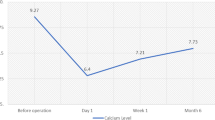Abstract. Intact parathormone (inPTH) has a short half-life. Its blood level on the first day after total parathyroidectomy and subcutaneous parathyroid implantation (PTX + G) should therefore allow an early diagnosis of missed residual parathyroid tissue. We tested this hypothesis in 72 uremic patients who were followed for 6 to 110 months after operation. Nine were reoperated for recurrence of the disease. Graft removal was successful in four patients who had post-PTX inPTH levels of 16 pg/ml or lower. In five patients, an overlooked parathyroid gland had to be resected. All of them had elevated post-PTX inPTH blood levels ranging from 72 to 791 pg/ml (upper normal limit 55 pg/ml). Three of these patients had presented with hypocalcemia after PTX. We conclude that the inPTH blood concentration on the first day after PTX allows more precise evaluation of the efficacy of the surgical procedure than the postoperative evolution of blood calcium levels. It is also useful for localizing the source of excessive PTH secretion (graft or overlooked gland) when the disease recurs.
Similar content being viewed by others
Author information
Authors and Affiliations
Rights and permissions
About this article
Cite this article
Kinnaert, P., Tielemans, C., Dhaene, M. et al. Evaluation of Surgical Treatment of Renal Hyperparathyroidism by Measuring Intact Parathormone Blood Levels on First Postoperative Day. World J. Surg. 22, 695–699 (1998). https://doi.org/10.1007/s002689900455
Issue Date:
DOI: https://doi.org/10.1007/s002689900455




